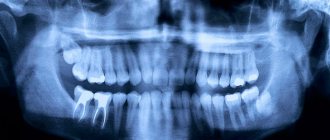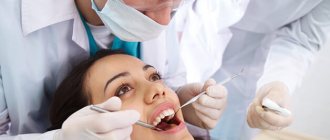Pericoronitis is an inflammation of the soft tissues surrounding the crown of a partially erupted tooth. It affects the gums, tissues around the tooth and can spread to the immediate environment. The most typical place for pericoronitis to occur is wisdom teeth, third molars. Not only do they erupt later than everyone else (and sometimes do not appear above the surface at all), but they also have a special structure. A long stay in a “sleeping” form, the influence of neighboring teeth change the position of the third molar, and it begins to erupt sideways, at an angle, further damaging the gum from the inside, which provokes pericoronitis of the wisdom tooth.
Causes and factors contributing to the occurrence of pericoronitis
Inflammation of the mucous membrane and gums above the wisdom tooth, as well as associated with the formation of the so-called hood - folds of the mucous membrane - is the main cause of the disease. Pieces of food accumulate inside this hood, which are a good substrate for the growth of pathogenic bacteria. The combination of inflammation due to tooth eruption (often long, difficult, with injuries to the mucous membranes) and the hood with altered microflora leads to the formation of a focus of infection in this place.
Other common causes of pericoronitis
- Gingivitis and periodontitis as background processes for the formation of inflammation, the formation of a periodontal pocket, in which bacteria also accumulate. After this, the process moves on to the surrounding tissue.
- Local injuries. A typical phenomenon: an incorrectly filled or partially broken tooth digs into the gum opposite or next to it, constantly injuring it. This leads to inflammation. Sometimes pericoronitis occurs in people wearing orthodontic appliances, which can injure the mucous membrane.
- Polyodontia, or teeth in excess of a set.
Why does there be an unpleasant odor?
Persistent bad breath is called halitosis. It appears due to anaerobic bacteria that live in dental plaque. These microorganisms emit gas that has a very unpleasant odor - it makes our breath stale. Moreover, the more bacteria in the mouth, the more unpleasant the breath becomes.
The ideal environment for the growth of microorganisms is food particles stuck in the interdental spaces and two- to three-day plaque, which quickly accumulates in the gum area. Over time, it mineralizes and turns into tartar, and bacteria begin to colonize it. Now, even if you brush your teeth with an electric brush and use an irrigator, you will not be able to completely get rid of bad breath on your own, since only a hygienist can remove tartar.
Bad breath can also be caused by:
- caries
- periodontal tissue diseases
- poor fit of crowns
- dryness of the oral mucosa due to diseases of the salivary glands
- Difficulty in erupting wisdom teeth
- dentures
- inflammatory diseases of the throat
- gastrointestinal diseases
- metabolic disease
Therefore, if you brush your teeth well, but the unpleasant odor still remains, then it is better to seek help from a dentist. He will find out what is the cause of halitosis and, if necessary, involve specialists from other medical fields in treatment.
Bad breath can affect both adults and children. The causes of halitosis are not related to age, but usually bad breath in a child occurs due to inflammation of the mucous membrane or due to pieces of food stuck in the carious cavity. If you notice that your child has bad breath, it is best to visit the dentist.
Symptoms of the disease
Symptoms of pericoronitis depend on the intensity and severity of the inflammatory process and the patient’s physical health. Signs of the disease can also be constant or periodically subside and be replaced by other complaints.
Possible general symptoms:
- Pain. It can intensify when you press on the source of inflammation, or it can be constant, pronounced or low-intensity. Sometimes it radiates to the ear, throat, nose, jaw.
- Redness or redness with an area of whitish skin.
- Swelling around the pericoronitis area.
- Unpleasant odor that gets worse after a night's sleep.
- Change in the taste of food, the appearance of a taste of blood or pus.
- Formation of a purulent sac on the gum.
- Difficulty opening the mouth, talking, chewing.
- Increased body temperature.
- General malaise.
- Difficulty sleeping.
- Enlargement of the cheek due to swelling of the jaw.
The course of the disease in different types of pericoronitis
Pericoronitis is divided into acute and chronic. Acute begins, as a rule, suddenly, is accompanied by inflammation of varying degrees of intensity, which affects the dental hood, spreads to surrounding tissues and, with severe inflammation, can cause complications from the body. This type of pericoronitis can occur as catarrhal and purulent.
In the case of catarrhal type, the disease occurs at normal body temperature and general satisfactory condition. Patients complain of pain when chewing or biting in the area of an erupting molar (or other cause of pericoronitis). With a long-term process, the lymph nodes under the lower jaw may become enlarged and painful.
If you look at the affected tooth, you can see that the hood or edge of the gum is red, there is swelling, in which the erupting tooth sometimes appears. Touching the source of inflammation is very painful, and when you press on it, serous fluid may be released. This form responds well to treatment. If the catarrhal form is not treated, then the inflammation can turn into a purulent form of acute pericoronitis.
In the purulent form of acute pericoronitis, the condition and well-being quickly deteriorate, the temperature rises to 38 ° C, the general condition, sleep, and appetite suffer. The pain becomes constant and severe. It radiates into the ear, into the back of the head, into the temple. Due to significant swelling, it becomes painful to swallow, open your mouth, and talk. The submandibular lymph nodes enlarge, sometimes so much that it becomes difficult to turn or tilt the head.
When you try to examine the source of inflammation, you can see that not only the hood of the wisdom tooth is swollen, but also the gums around the tooth. The swelling can also cover the inner surface of the cheek, the palate, and can spread all the way to the entrance to the oropharynx. If you touch this hood, the patient will experience sharp pain, and pus will be released from the lesion, sometimes smelling bad. Purulent pericoronitis responds well to treatment, however, it is possible that in an advanced case or with improperly selected treatment, the purulent process spreads to the jaw with the formation of phlegmon [1].
Chronic pericoronitis occurs if the acute one was not noticed, the inflammation on its own or with the help of medications went away or subsided. But since the actual cause is not eliminated, it periodically worsens and produces symptoms.
Most often, the process occurs at normal body temperature and satisfactory general condition. In this case, there is an aching, constant, rather pronounced pain, which can interfere with chewing and talking. Enlarged, mobile, painful submandibular lymph nodes can interfere with head movements. Soreness can radiate to the ear, temple, jaw, and throat. An unpleasant odor appears from the mouth; touching the area of inflammation with the tongue or accidentally pressing it is painful. If you look at the area of inflammation, you can see that the gums above the hood begin to lag behind the tooth. Chronic pericoronitis requires treatment. Otherwise, complications may develop, including the formation of ulcers and phlegmon.
How to get rid of bad odor: folk remedies
You can remove bad breath on your own if the symptom is caused by external factors - dietary errors, poor oral hygiene, bad habits. The use of traditional methods must be agreed with a doctor; self-medication should not be practiced.
- Drinking regimen
- the simplest thing for fresh breath is to drink enough water. Dry mouth promotes the proliferation of pathogenic microflora, which produces an unpleasant odor. - Balanced nutrition
- a healthy diet includes foods high in vitamins, minerals, and microelements. Minimizing simple carbohydrates (baked goods, sweets), aromatic foods (raw onions, garlic), legumes, spices, coffee, and alcohol will help make your breath fresher. It is recommended to introduce more apples, carrots, broccoli, and fermented milk products (ryazhenka, kefir, yogurt reduce the level of hydrogen sulfide, hard cheese reduces the acidity of food). - Mouth rinse
- using decoctions of medicinal herbs (mint, fennel, chamomile), special rinses helps remove food debris, prevents gingivitis, and freshens breath. - Cleaning the tongue
- bacteria that cause bad odor accumulate not only on the teeth, but in the hollows and cracks of the tongue, so it needs to be cleaned daily with special scrapers and brushes.
Home methods of combating bad breath will perfectly complement self- and professional hygiene. Simple measures will help eliminate the cause of the bad odor and avoid the development of a serious illness.
Many patients are interested in how to get rid of bad breath and quickly freshen their breath. The following methods will help:
- brushing teeth with a paste with a pronounced aromatic effect (ice mint, menthol);
- using a refresher (mouthwash, active oxygen spray, mouth foam);
- chewing parsley, dill, cloves, cardamom, ginger;
- use of pepper, mustard, and other hot spices in dishes.
Such measures will not help in the treatment of halitosis, but they can temporarily eliminate the bad smell before important negotiations, meetings, or dates.
Treatment of pericoronitis
Treatment of pericoronitis has several tasks:
- Eliminate pain.
- Combating the pathological process, preventing its further spread and preventing complications.
Typically, both acute and chronic pericoronitis are treated on an outpatient basis [1]. Elimination of pain is carried out simultaneously with the fight against acute inflammation. In case of catarrhal form, the doctor cleans and treats the gums and hood with an antiseptic and applies a special bandage, which simultaneously treats with medicinal impregnation and lifts the hood [1]. In this way, conditions are created for the process to subside and, if necessary, for the eruption of the third molar.
For purulent pericoronitis, surgical treatment may be required, which is also carried out in a dental clinic. The hood is excised, the wound is treated with special therapeutic bandages and the resulting pocket is lifted so that it does not again begin to interfere with the tooth and does not provoke inflammation.
Anti-inflammatory drugs, antihistamines and antibiotics may be prescribed. After the pain has subsided and the inflammation has subsided, the dentist evaluates the possibility of saving the tooth or the need to remove it. For this purpose, a complex of studies is carried out, including examination, laboratory tests, and x-rays. Based on the results of this examination, the tooth is either removed or given the opportunity and “space” to erupt.
After your wisdom tooth is removed, you will need to come back the next day for an examination.
This will allow you to assess the condition of the hole and mucosa. If the tooth is saved, it will need to be shown to a doctor once every 6 months. Clinical guidelines (treatment protocols) for the diagnosis of pericoronitis [1]
Causes
The appearance of bad breath after dental surgery may indicate an infection or inflammation that affects the bone and periodontal tissues.
The appearance of an unpleasant odor after the removal of a wisdom tooth is caused by infection of the socket, poor oral hygiene, the development of dental diseases, and the ingress of splinters from an instrument.
A doctor will help you fix the problem.
Most often, this condition is noted by patients 3-5 days after removal. If you do not seek medical help from a specialist in a timely manner, microbial plaque, redness, swelling and numbness begin to appear on the surface of the tissues. In addition, purulent contents may leak from the hole.
It is recommended to drink enough fluids and use a moisturizing mouthwash in the first few weeks after wisdom tooth removal.
Dry mouth contributes to bad breath. The use of anesthetics and gum gels can also cause drying.
Dentist
Novikova Olga Alexandrovna
8 years of experience
There are several reasons that provoke infection to enter the wound, resulting in an unpleasant odor.
Dry socket formation
Within two hours after the process is completed, a blood clot begins to form in the place of the former tooth. Its peculiarity is to protect fabrics from the penetration of microbes, food particles, pasta and other foreign substances.
This formation is not subject to extraction. In some cases, it is washed out on its own, which leads to drying out of the wound.
This phenomenon can occur in patients who smoke, as well as in those who have poor blood clotting. Dryness of the socket leads to its rapid filling with saliva, pathogenic bacteria, and food. Against this background, pathologies begin to develop that contribute to the appearance of an unpleasant odor.
Failure to comply with hygiene rules
After wisdom tooth extraction, the specialist gives the patient certain recommendations for further wound care. This includes:
- gentle rinsing with antiseptic and healing solutions;
- a gentle cleaning process that avoids the injured area.
Is it painful to have wisdom teeth removed?
A person has 32 teeth, four of them are called wisdom teeth.
In addition, it is prohibited to use irrigators and dental floss near the wound. You should also not touch it with your hands, tongue or cotton pads. It is recommended to refrain from eating and drinking for at least three hours. You can only drink clean water.
Over the next three days, you must adhere to a certain diet:
- include that are soft and neutral in chemical composition in your diet;
- eat food only at room temperature;
- exclude too salty, spicy and sweet foods.
If you do not follow all the above recommendations, this may lead to irritation and bleeding of the hole. Under the influence of negative factors, it is possible that the blood clot, which protects the wound from the penetration of bacteria, is washed out. Such conditions contribute to the penetration and reproduction of pathogenic microflora in the hole.
Shard of a tool or tooth
In some cases, due to the negligence and inattention of the dentist, a small part of the dental tissue or damaged instrument may get into the hole during the removal process. This, in turn, provokes the development of a strong inflammatory process in the tissues, which is accompanied by:
- swelling of the wound;
- soreness;
- bleeding.
The consequence is also the appearance of a putrid odor from the oral cavity.
Dental pathologies
Against the background of inflammation occurring in the hole, certain complications may develop. Carious lesions of adjacent dental units cannot be excluded. Since a large number of pathogenic bacteria accumulate in the wound, they immediately begin to affect healthy areas, especially if their destruction is already observed (plaque, tartar, carious cavities).
Why can our articles be trusted?
We make health information clear, accessible and relevant.
- All articles are checked by practicing doctors.
- We take scientific literature and the latest research as a basis.
- We publish detailed articles that answer all questions.
Another cause of poor breathing is inflammatory processes occurring in the gum tissue and socket pockets (periodontitis, periodontitis). In rare cases, gingivitis and stomatitis may occur.
An inflamed wound, combined with a weakened immune system, can provoke a variety of pathological conditions in the oral cavity, each of which is accompanied by an unpleasant odor.
Recommendations for patients
If an incision or excision of the hood was performed in the treatment of pericoronitis, it will be necessary to follow several preparatory and postoperative measures that will speed up healing and reduce the risk of complications.
- For two to three hours after the intervention, do not take food, hot drinks, or alcoholic drinks.
- On the day of the operation, do not go to the bathhouse, sauna, take a hot bath, or be in the sun or in a hot room.
- Limit physical activity the day before and on the day of treatment.
- During these days and the next three days, it is recommended to follow a diet, exclude alcohol, spicy, very hot foods.
- Before the intervention, you should not eat foods with a strong smell.
- Smokers should quit cigarettes the day before the hood excision, on the day of surgery, and two days after.
- For sanitation (cleaning and disinfection), you can use a mouth rinse with antiseptic solutions.
- After the intervention, the doctor will prescribe medications that accelerate healing.
- Do not apply warm compresses or ointments containing bee, snake, etc. venom.
- If after excision of the hood or placement of therapeutic turundas there is pain, severe swelling, increased discomfort, pain in the area of the submandibular lymph nodes, you need to consult a doctor to identify the cause and take action.
Halitosis, or why your breath smells bad...
Very often (according to statistics, this is every fourth person) we are faced with the problem of bad breath . It may occur occasionally and may be chronic. But in any case, this trouble greatly complicates our communication with other people. Where does this misfortune come from? How to get rid of it? How can a dentist help with this? Let's try to figure it out.
Let me make a reservation right away that we will not talk below about those cases when you dined on a delicious salad with onions or saved yourself from a cold by eating heads of garlic. The aroma of your breath, which is unpleasant for others, in this case has a completely clear nature. We will talk about halitosis, which accompanies various diseases and pathological conditions.
Where to look for the causes of bad breath? In general, oddly enough, everywhere... right in order.
♦ In the oral cavity ♦ In the upper respiratory tract ♦ In the gastrointestinal tract ♦ In the endocrine glands
How to deal with unpleasant odor? If possible, you should always try to find and eliminate its cause. Masking with chewing gum, candy and mouth sprays will remain just a disguise. Therefore, let’s go over the main non-dental problems, and then we will take a closer look at how dentists can help in solving this problem.
So, what are the main respiratory diseases that are accompanied by an unpleasant odor? Most often (especially in our not-so-best northern climate) this is chronic tonsillitis. You can go to the mirror, look into your mouth, say “AAAAAA” and try to look at your tonsils (or as they are often called “tonsils”). If you completely by chance took a course for novice ENT doctors, you will probably be able to see their enlargement, the presence of films and plugs.
The arrows show inflamed enlarged tonsils with white plugs. They are the cause of the unpleasant odor in chronic tonsillitis.
If you have not completed such courses, then you just need to go to this very “ear-throat” specialist, who will definitely figure out whether there is something on the tonsils or not, and if there is, what to do about it. I am not an expert in this case, so I won’t give out advice. In addition to tonsillitis, chronic inflammatory processes in the pharynx (pharyngitis), nose (rhinitis), and sinuses (sinusitis) can also cause stale breath. They are less often accompanied by halitosis, but still... In any case, in search of the cause of bad breath, an otolaryngologist (ENT) should immediately follow the dentist (if he has not found anything, or has already done everything he can in his domain).
If the dentist has not found possible causes of halitosis, then the next step should be to visit an ENT doctor for examination.
Let's move on... Next (from an anatomical point of view) we have the gastrointestinal tract and everything connected with it. Here there are many different reasons for the appearance of halitosis . Again, without getting carried away with gastroenterology, let’s just try to briefly go over the main and most common of them. These can be gastritis, diseases of the duodenum (which comes immediately after the stomach), diseases of the liver and gall bladder. When food is in the gastrointestinal tract for a long time, it does not cope well with its digestion, it begins to ferment, rot, and in general processes occur to it that cause the formation of unpleasant-smelling gases. Moreover, these gases are not so much released directly from the stomach as they are absorbed into the blood and then released by the lungs. A gastroenterologist should figure out exactly what the problem is and adjust your diet. You should contact him immediately after the dentist and ENT doctor.
And finally, diseases of the endocrine glands. One of the main ones is diabetes mellitus associated with the pancreas. One of the manifestations of this unpleasant disease is the characteristic smell of acetone in the exhaled air. Hormonal changes in women during pregnancy and menopause, when taking oral contraceptives, can also contribute to the appearance of halitosis. Accordingly, these problems should be addressed to an endocrinologist.
In addition to the reasons mentioned above, we can also talk about cancer, tuberculosis, kidney failure and other serious pathologies that may be accompanied by a bad odor. These problems, however, are so serious that bad breath is the last thing that will worry such patients in their condition. From this you just need to understand that halitosis can accompany quite serious diseases of the internal organs, so it is always worth understanding its causes.
In addition to pathological reasons (i.e. various diseases), a bad odor can also appear due to physiological reasons. For example, if you are hungry. People who actively follow “hunger” diets often suffer not only from irritability from a constant feeling of hunger, but also from halitosis.
You should also not abuse foods rich in easily digestible carbohydrates (sweets, flour), because It is an excellent nutrient for microbes, and therefore is more likely to support bad breath. This is quite briefly about all the non-dental variants of halitosis. Now let's go back to the beginning, i.e. to the oral cavity. And let’s dwell on it in more detail, because it is problems in the mouth that most often cause the appearance of chronic unpleasant odor. For the most part, we get bad breath due to the activity of bacteria that have a permanent residence in our mouth and feed on the same things we eat. This means you simply shouldn’t give them a feast, forgetting about basic hygiene products. They provide protection from both caries and bad breath. We most often create “food warehouses” for microbes between the teeth, on the inner surface of the side teeth, in the area of the wisdom teeth (if any) and on the back of the tongue. These are the places that are most poorly cleaned by average daily hygiene. What to do? The answer is simple - proper hygiene. In addition to the standard 2-3 minute (this, of course, is still the best case scenario) spreading toothpaste over your teeth, it would be nice to:
→ Use floss 2 times a day to clean all interdental spaces, since no toothbrush can penetrate there even with very careful use;
→ try not to snack between main meals, and if you really want to do this, then not with hamburgers and cookies, but with fruits and salads from fresh vegetables. Particularly useful in this sense are solid foods (apples, carrots), which promote self-cleaning of teeth, as well as parsley and celery. After a snack, it is advisable to rinse your mouth with water, a special mouthwash, or use chewing gum (2-3 minutes, no more);
→ do not forget to clean the back of the tongue along with your teeth, because bacterial plaque forms on it in large quantities. This must be done carefully, but without fanaticism, so as not to damage the mucous membrane. This should be done especially carefully by owners of the so-called. folded or “geographical” tongue with many depressions in the mucosa.
But even owners of “standard”, at first glance, smooth tongues should know that on the mucous membrane of this organ there are so many secluded places for preserving bacterial plaque that the main hordes of bacteria live right there, especially closer to the root of the tongue. This is what a section of mucous membrane looks like under 300x magnification...
This uneven surface structure is a home for the microbes living in our mouths. Therefore, you need to regularly and thoroughly clean not only your teeth, but also your tongue.
An extreme degree of sloppiness in relation to hygiene can be the formation of tartar (most often on the inner surface of the lower teeth), periodontitis (inflammation of the gums). These problems always result in a persistent, chronic, unpleasant odor. In this case, treatment by a dentist is already necessary, which begins with putting things in order with professional hygiene. And then - as it gets neglected.
Halitosis often accompanies people with carious teeth in their mouth. Moreover, cavities can be hidden (for example, between teeth). Therefore, even if you yourself do not find “holes” in your mouth, to diagnose hidden caries you need to contact a dentist and have the damaged teeth sanitized.
Another common cause of halitosis is a dysfunction of the salivary glands, in which they produce too little saliva. In this case, chronic dry mouth (xerostomia) appears. Since saliva has antibacterial properties, its decrease leads to an increased increase in the number of microbes and the appearance of halitosis. Xerostomia, by the way, often appears in old age, which is why older people so often have problems with bad breath. Dry mouth also often occurs in smokers and when drinking alcohol. But even in healthy people, saliva secretion is significantly reduced during sleep. This is why, even with careful hygiene before bed, our breath is not very fresh in the morning. What to do in these cases? Quit bad habits, drink more water during the day, use means to stimulate salivation (from banal chewing gum and sweets to special medications).
Another common cause of halitosis is wisdom teeth. They tend to be difficult to clean and therefore often leave quite a lot of residue behind. Hence the smell. In addition, if the 8s have not yet fully erupted, then they can create even more difficult-to-reach nooks and crannies in which bacteria can live and multiply perfectly. You can read more about wisdom teeth here. How to treat? As a rule, the most radical way is removal.
Dentures are another cause of halitosis. But not on their own, but, again, in collaboration with insufficient hygiene. Some types of dentures, due to their structure, are provoking factors for the accumulation of plaque. These are bridges and crowns fastened together into a single block. Under the connecting elements, under the hinged teeth, food debris easily accumulates.
Therefore, if possible, you should avoid such prosthetic options in favor of single separate crowns. If you really can’t avoid it, use the most careful hygiene using special means: superflosses, brushes, irrigators.
A similar problem applies to all types of removable dentures. They must be removed after each meal and rinsed both the mouth and dentures. In addition, plastic, which is used to make removable dentures, has the unfortunate property of accumulating odors over time and serving as a haven for bacteria. This occurs due to its microporous structure and the appearance of scratches on the surface of the prosthesis over time. If fate has not allowed you to avoid the appearance of removable dentures in your life, then learn to care for them no less carefully than for your teeth. Do not use harsh abrasives for cleaning (soda, tooth powder, Pemolux, etc. should not touch the surface of the plastic). Nowadays, for effective cleaning of dentures, there are special ultrasonic baths in which the process occurs most efficiently and safely for the denture itself.
In addition, you can easily purchase special tablets for the care of removable dentures in pharmacies. These simple and inexpensive products will preserve the original appearance of plastic for a long time, preventing bacterial plaque from accumulating on it, and will protect it from the appearance of an unpleasant odor. If, after some time, the plastic on the prosthesis becomes scratched and the glossy shine of the surface has disappeared, then it would be a good idea to take the prosthesis to the doctor for professional polishing. Proper care of your removable dentures will significantly reduce the likelihood of bad breath. This is the main thing that is important to know if you are faced with such a scourge as bad breath. This problem is not only medical, but also clearly social in nature. Those. Simply put, you can easily ruin an important meeting with a business partner, or a first date with the opposite sex...
In many cases, chronic halitosis requires medical intervention and cannot be corrected on its own. In addition, it is important to remember that bad breath can signal the onset of quite serious diseases, which are important to recognize and begin to treat as early as possible. I hope that this article will help you understand that masking the smell with candies with “icy freshness” will not solve your problems, and will help those who are already looking for a solution to navigate how, where, and from which doctors to look for and eliminate the cause.










